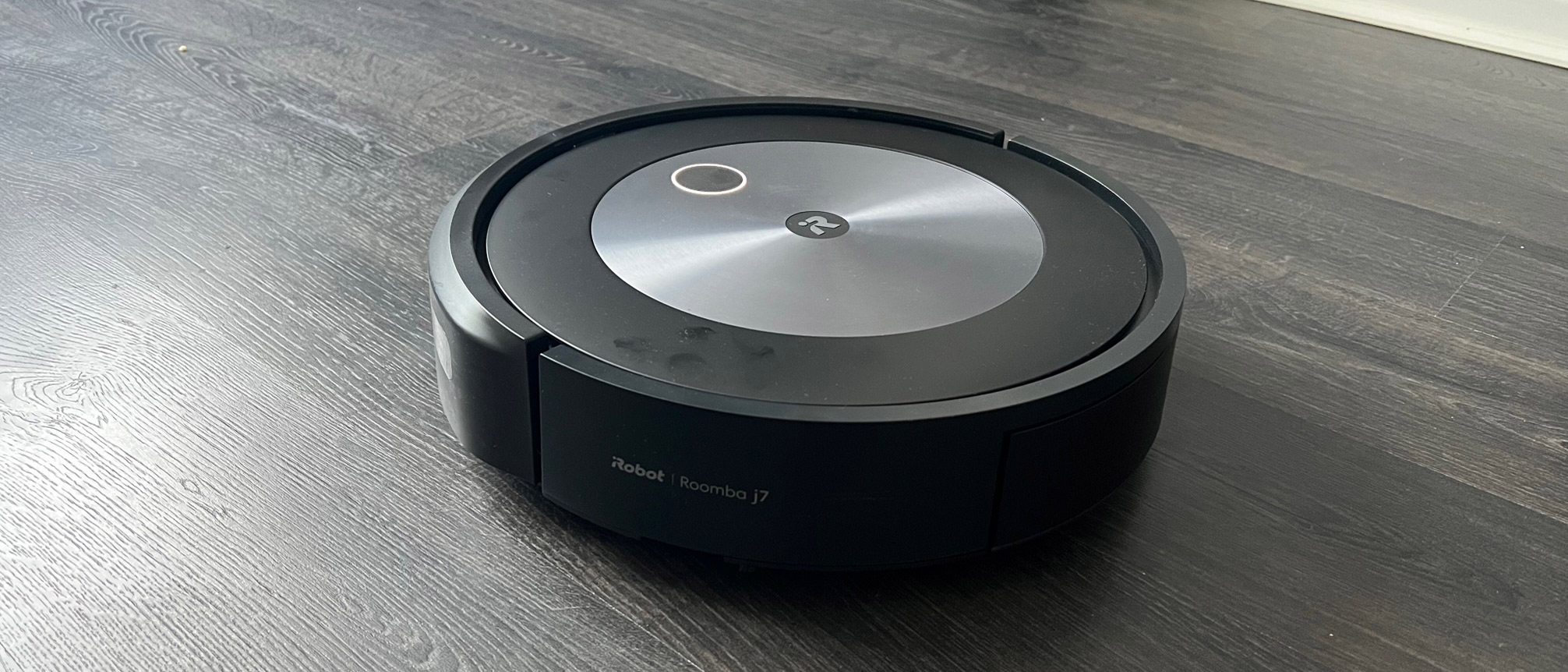TechRadar Verdict
The iRobot Roomba J7+ is a powerful robot vacuum that collects fine dust and larger debris from carpets and hard floors, while also avoiding obstacles such as charging cables and the odd sock that may appear in its path. It includes iRobot’s P.O.O.P (Pet Owner Official Promise), which means you can rely on it to avoid pet waste on purpose, too. Simple to use, it's self-emptying and loaded with smarts that ensure it can be set only to vacuum when you’re out. Dual rubber brushes stop hair getting tangled – but this robovac is expensive, and noisy when emptying its own dust box.
Pros
- +
Excellent pick-up on carpet and hard floors
- +
Automatically avoids pet mess
- +
Self-emptying
Cons
- -
A little noisy – especially when emptying its bin
- -
Side brush flicks larger debris around the room
- -
Battery level isn’t clear
Why you can trust TechRadar
One-minute review
Editor's note: Several newer Roomba lines have now been released. This review remains as originally published, but you can see how the j7+ compares to the current range in our article covering 'Which Roomba should I buy?'
Having been around for more than two decades, iRobot was one of the first brands to launch into the best robot vacuum market. Thanks to a combination of innovative technology and powerful suction, the Roomba name continues to dominate the automated floor-cleaning market. iRobot claims 20% of robot vacuums sold are Roombas, so it’s no surprise that many of its models feature in our list of the best robot vacuums you can buy right now.
The Roomba J7+ is the brand’s latest robot vacuum, sitting between the top-of-the-range Roomba S9 Plus and the Roomba i7 Plus. While it can’t match the suction power of the S9, it was able to collect dust and debris from both hard floors and carpets as effortlessly as the i7.
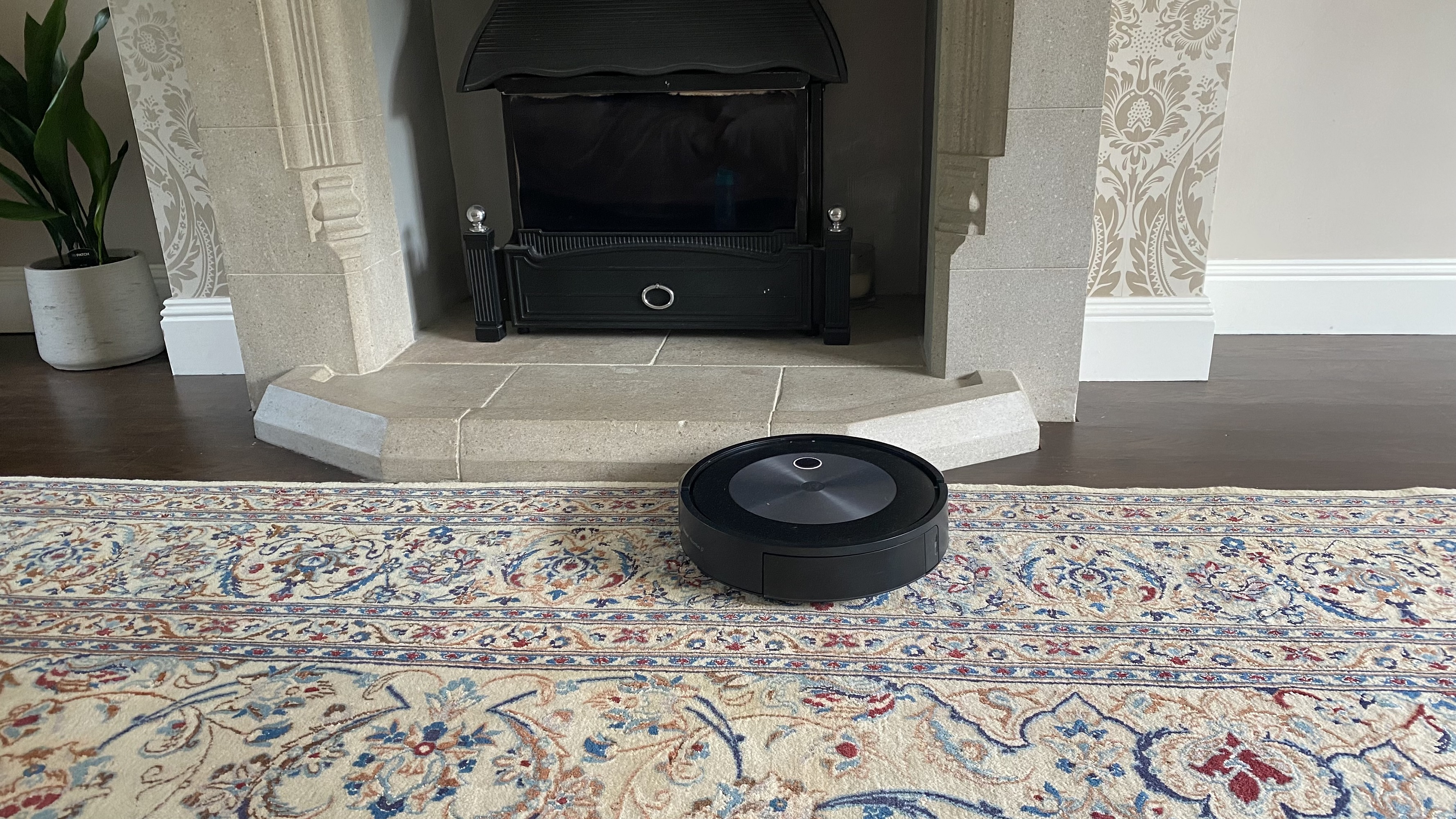
It’s also iRobot’s smartest Roomba to date, using built-in AI to detect and identify obstacles – such as a charging cable left on the floor, or a sock that’s escaped on its journey from the laundry basket to the washing machine. Its special feature is its ability to identify obstacles and avoid hazards as it vacuums – in particular pet waste. It will clean as close to such items and / or waste as possible, without ploughing through them, avoiding them becoming tangled in the brush roller.
The Plus moniker refers to the fact this is a self-emptying robot vacuum. Supplied with a base station that’s one of the most compact we’ve seen to-date, the robovac will deposit the contents of its 14oz / 0.4-liter dust canister into a 57oz / 1.7-liter bag that is likely to require replacing only around every 60 days – although this will depend on how often the robot vacuum cleans your floors. Note that this does mean there’s an on-going cost associated with this robot vacuum.
If you want to have a totally hands-free approach to vacuum cleaning then team the J7+ with your smart assistant to use voice assistant for controlling its functions and command it to clean a certain room when you need. With its unique ability to detect and avoid pet waste – a bit of an issue until now – as well as pick up particles as small as .7 microns, we think this is a particularly good buy for anyone with a cat or dog.
At $799.99 / £899.99, the Roomba J7+ is one of the more expensive robot vacuums on the market, especially when you consider that it doesn’t offer mopping functionality alongside vacuuming. However, for those looking for the most hands-off route to cleaning, not having to spend time clearing the floor before the vacuum gets to work, it’s worth the investment. Plus, it's also massively discounted right now, thanks to the Roomba Black Friday deals that are live now.
iRobot Roomba J7+ price and availability
- List price: $799.99 / £899.99 / AUS $1,799
You can currently buy the Wi-Fi Connected iRobot Roomba j7+ Self-Emptying Robot Vacuum online directly on the iRobot website and at Amazon for $799.99 / £899.99 / AUS $1,799. At the time of writing it comes with two AllergenLock bags, a spare edge-sweeping brush and filter as part of the package.
While this price tag may feel a little steep for a robot cleaner that can’t clean stairs, it comes with a convenient smart app to control it remotely and notable features designed to make household chores a breeze. It can avoid pet waste, charging cords and items left on the floor such as shoes and socks when cleaning, and has the ability to automatically empty its bin on its own using the enclosed bag system. The J7+ has a 10 x Power Lifting Suction compared to it standard 600 series. Pay a bit more for the brand’s Wi-Fi Connected Roomba s9+ Self-Emptying Robot Vacuum, priced at $1,217/ £999 / AUS $2,899, and you can benefit from 40 x Power Lifting Suction. You won’t, however, benefit from as many smart features as the J7+ such as the ability to avoid pet mess on purpose.
The robot vacuum is also available without the self-emptying base. Known as the iRobot Roomba J7, it’s priced at $599.99 / £699.99.
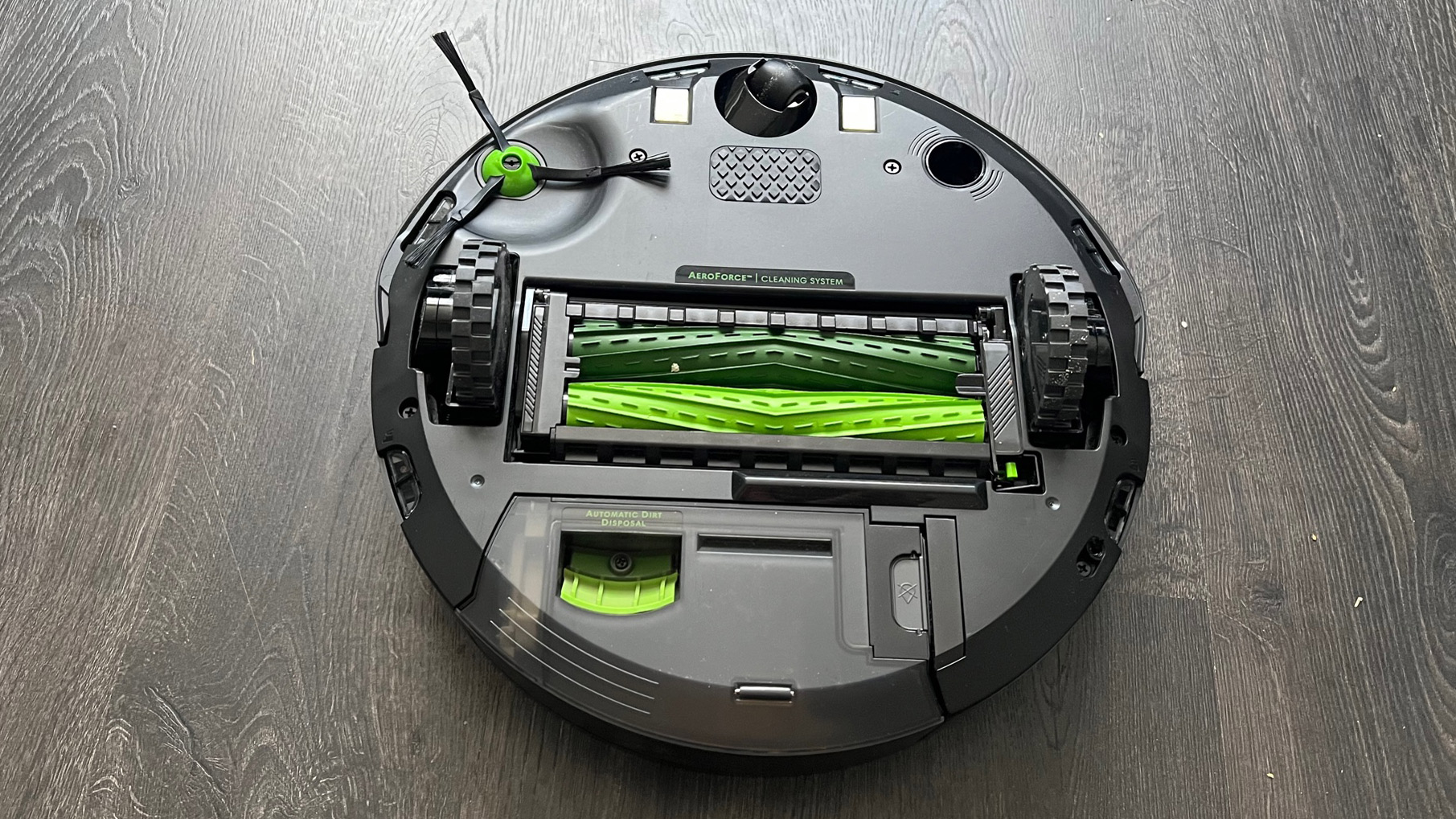
Design
- 14oz / 0.4-liter dust box
- Steers clear of pet mess with its P.O.O.P offering
- Floor and cliff sensors, and built-in camera
Unlike the Roomba S9 Plus, which sports a D-shaped design, the Roomba J7+ is circular in shape. Measuring 13.3 x 13.3 x 3.4 inches / 33.8 x 33.8 x 8.6cm, the Roomba J7 is sleek, fusing matte black plastic with gunmetal accents. The top of the robovac is completely flush, home to only one button to start and pause cleaning, or held down for five seconds to send the robot vacuum back to its base.
A plastic bumper surrounds the top half of the robot vacuum, while on the underside sit two wheels and a swivel wheel to help the robot vacuum work its way around your home. Dual rubber brush bars flex to accommodate different floor types, says iRobot, and ensure hair – whether human or pet – doesn’t become tangled around them. There’s also a three-arm side brush for cleaning edges and any crevices in a room.
The J7+ comes with a 14oz / 0.4-liter dust box, and benefits from floor tracking and cliff sensors, alongside a built-in camera, to enable it to take a methodical route around your home – and to stop it from plunging to the bottom of a flight of stairs. Unlike many robot vacuums on the market, you can’t manually adjust the suction level here; but the J7 Plus will automatically increase the power if it detects a particularly dirty area of the floor.
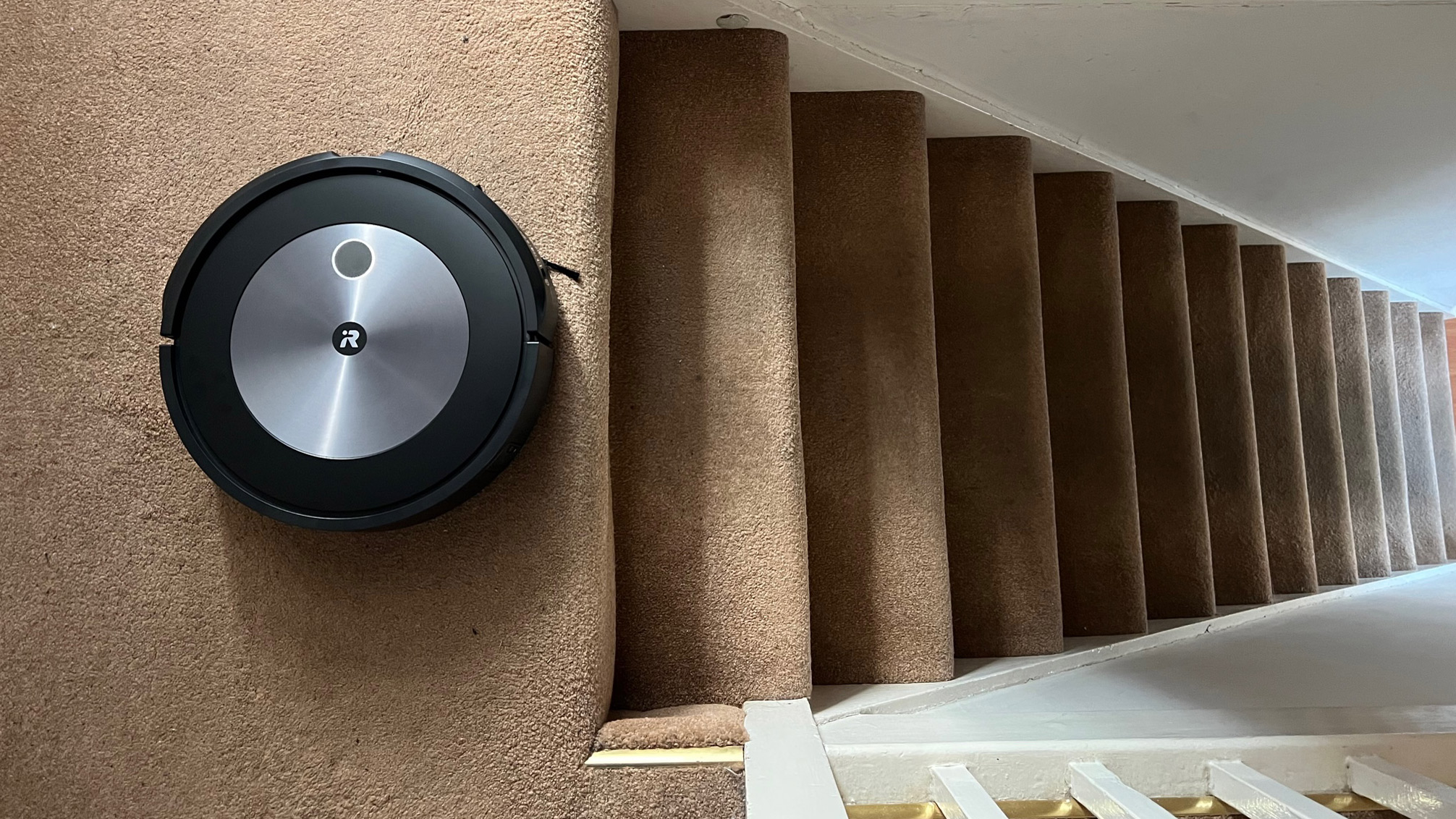
As mentioned, the J7+is self-emptying and comes with iRobot’s Clean Base. Measuring 12.55 x 13.39 x 15.35 inches / 31.9 x 34 x 39cm (h x w x d), it’s compact and features a textured design, giving it a more stylish look over most charging and self-emptying docks. There’s even a brown leather tag on the lid, to make opening it easier. The Clean Base comes with two dirt disposal bags, one fitted into the Clean Base and a spare. iRobot says the bags can hold up to 60 days worth of dirt before they need to be replaced and once the bin is full you’ll be notified via the LED indicator light that will turn solid red.
The vacuum comes equipped with both sensors and a camera. It will activate its own Dirt Detect Technology when it comes across an area that needs more attention and clean that area until it detects fewer particles. Meanwhile, the built-in camera helps the robot navigate and avoid mess. Having the ability to detect pet mess is a particular bonus for this model. We also love the fact that you can use it when you leave the house – even if you have your burglar alarm on – as it is designed to be lower than the alarm line’s threshold.
- Design: 4/5
Performance
- Excellent pick-up on carpet and hard floors
- Can identify and avoid an array of obstacles
- Gentle on Persian carpet tassels
When it came to pick-up, the J7+ made light work of collecting fine dust, cookie crumbs and larger debris – including cereal – from hard floors. However, on hard floors we did find that the side brush had a tendency to push larger debris further around the room, which made the vacuuming process slightly longer than we’d hoped.
Unlike many robot vacuums on the market, it isn’t possible to manually adjust the suction level of the J7+. However, the robot vacuum can sense if areas of the floor are particularly dirty, and it will increase the suction to accommodate. This was evident through testing, as our decibel meter registered noise climbing by around 5db. As we’ve already mentioned, the J7+ can create maps of your home, and it’s possible to save maps of different levels. This meant we were able to clean both the ground and first floor of our home successfully.
The robot vacuum took a methodical route around our home when vacuuming, and thanks to the on-board camera, it only occasionally bumped into furniture. We were also impressed that the J7+ was able to identify and avoid obstacles, including a charging cable and a sock, which we deliberately placed in its path. We also wanted to know if it would be powerful enough to accidentally pick up a small plastic toys the kids had left laying around the house and get jammed in the cleaner. Luckily, we found it trying to move toy obstacles out of the way by pushing through them rather than sucking them up.
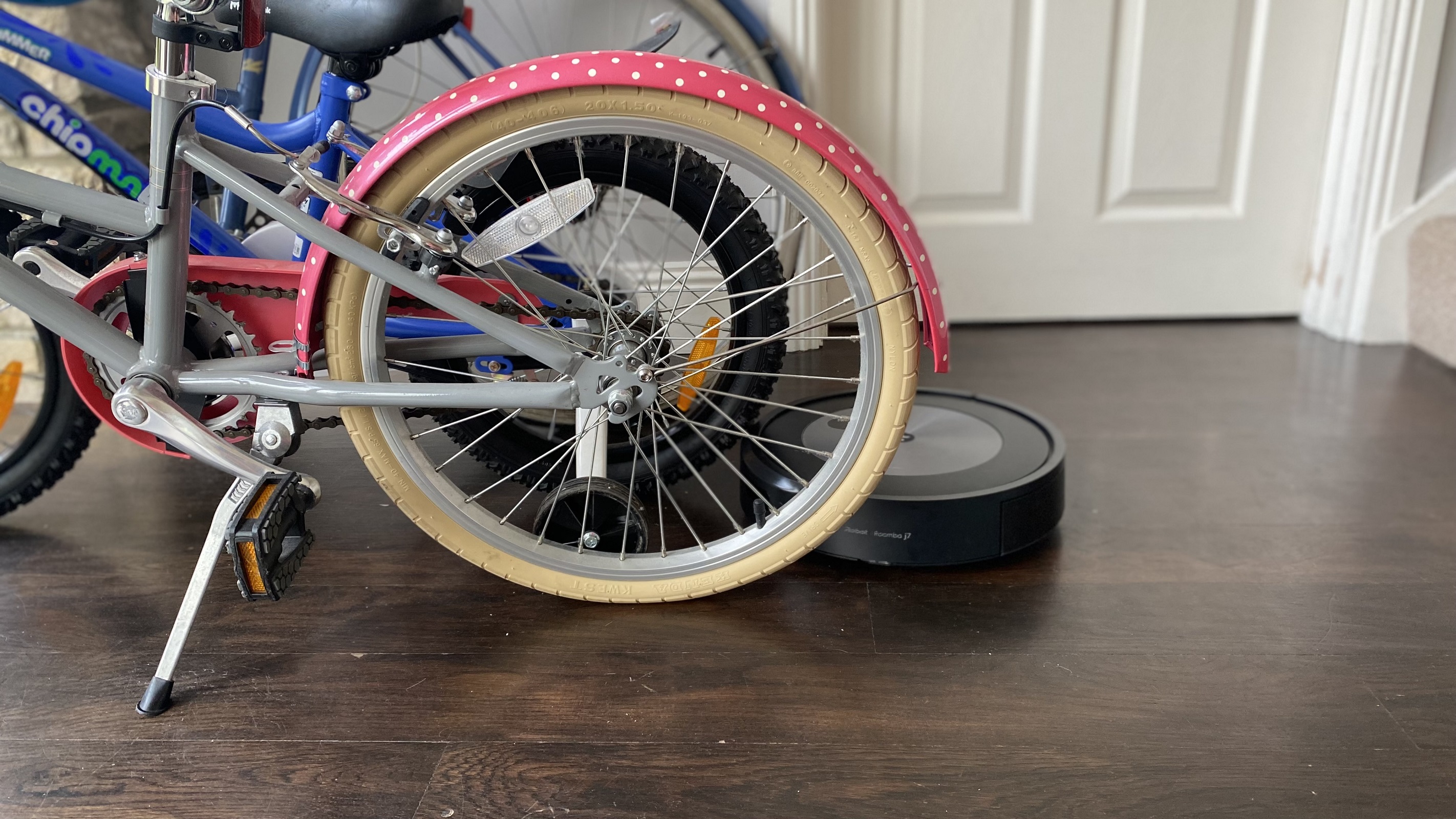
We were also concerned about the floor-trailing curtains in the living room, but this didn’t seem to cause any problems as the vacuum stopped before touching them and turned away. If your curtains do touch the floor, this will mean you’ll have to manually lift them out of the way to get a more thorough clean, however.
A big bonus of this cleaner is that it will avoid pet mess, so we reluctantly left some cat mess in the middle of the room to see if the vacuum would steer clear. We’re pleased to say that it did.
To see how well the robot did at picking up fine dust, we created our own mess with 10g of crushed digestives and 10g of flour and sprinkled the mixture on both the hard floor and carpet. We did the same with 10g of oats, to see how well it did at picking up larger debris. We then used the app to create a ‘clean zone’ so we could pinpoint where we wanted the iRobot to go. If you team it with voice assistant you can then also say something such as “Alexa, tell Roomba to clean in front of the kitchen counter”.
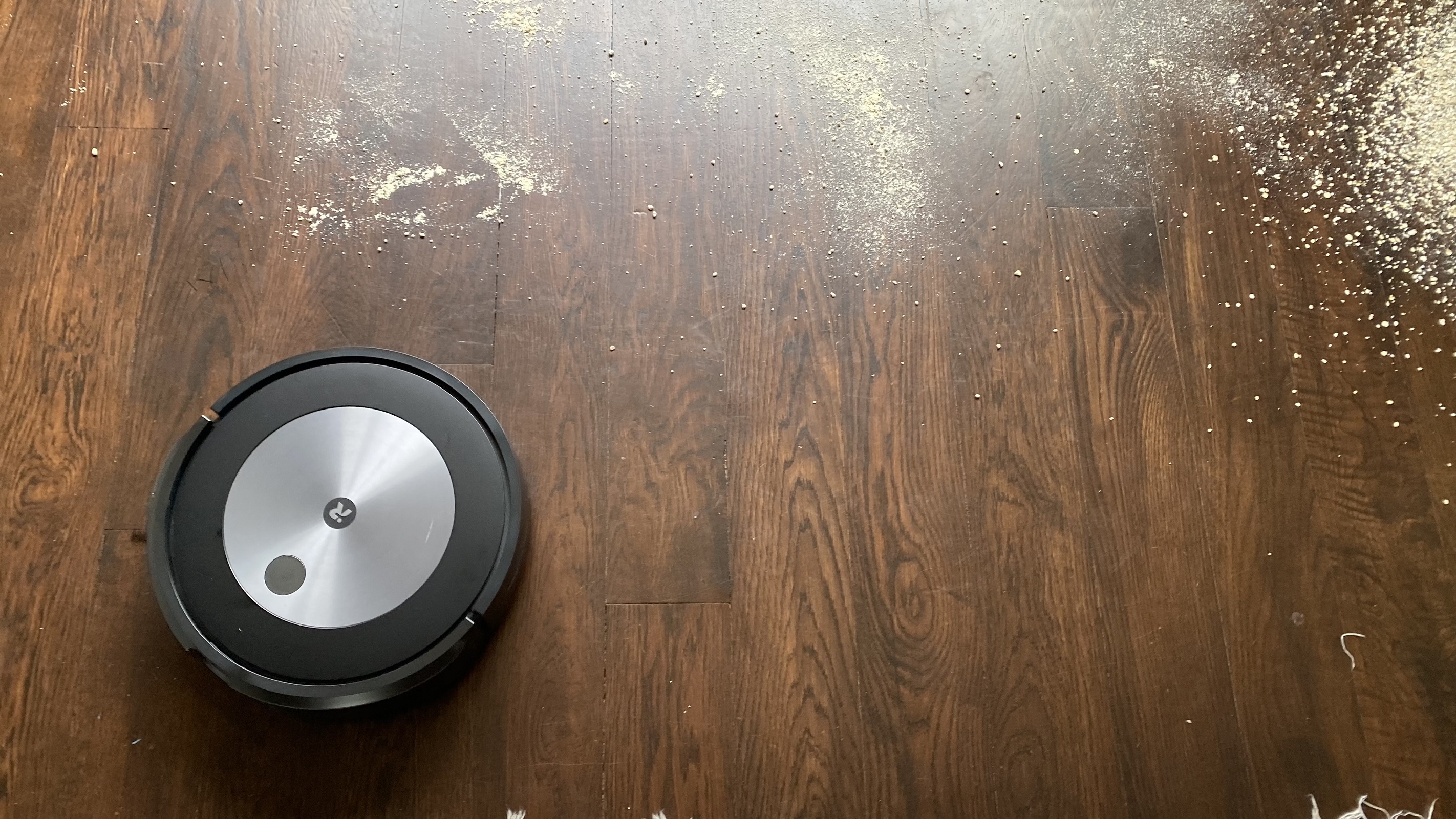
Unfortunately, the vacuum didn’t do as well as we’d liked. While it did identify the mess and is meant to clean systematically, its brush threw the digestive and flour mix and oats away from it before going back to attempt to pick it all up. It then found it all a little too much and spewed out the oats on its way back to the charging station. In contrast, the vacuum did very well giving the home a general clean with day to day dust, hair and dirt already scattered around the floor. We set it to do a general clean everywhere and were pleased to find how well it did an overall clean and found the iRobot sitting contently back in its dock after cleaning.
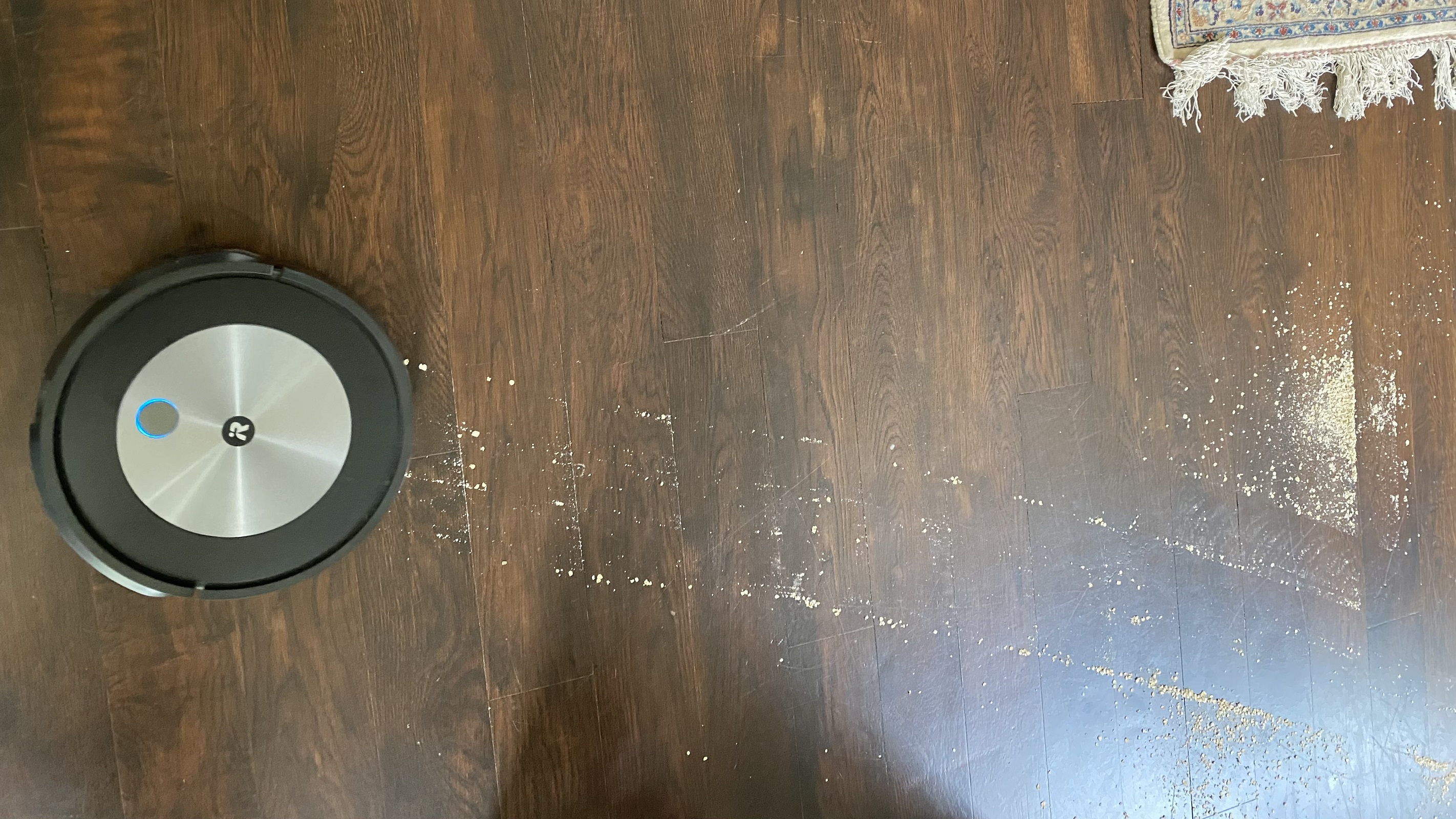
The J7+ robot vacuum proved pleasingly quiet in operation, whether cleaning hard or carpeted floors, registering a maximum of 64db on our decibel meter during use. This is similar to the sound of general chatter in an office.
Even better, if you interrupt a clean to ask the robot vacuum to tackle a specific area, it will shut down the vacuuming components of the device, so it’s as quiet as possible while moving between jobs.
Low noise doesn’t extend to those times the robovac docks and empties its dust canister – in this instance our decibel meter hit 90.6db, which is the sound you’d experience standing 20ft from an automatic car wash. This makes the J7+ one of the noisiest robot vacuums we’ve tested.
We were impressed with the J7 Plus’s geofencing feature, however, which started the robot vacuuming once we’d left the house, so it didn’t get under our feet. Even better, we were able to set the robot vacuum to stop cleaning and return to its base station if it hadn’t completed vacuuming by the time we’d returned home. Alternatively, the robot vacuum will pause cleaning if you return home before it’s finished, sending you a notification to ask whether it should continue. Note that this geofencing feature does require an IFTTT account, which is free to set up.
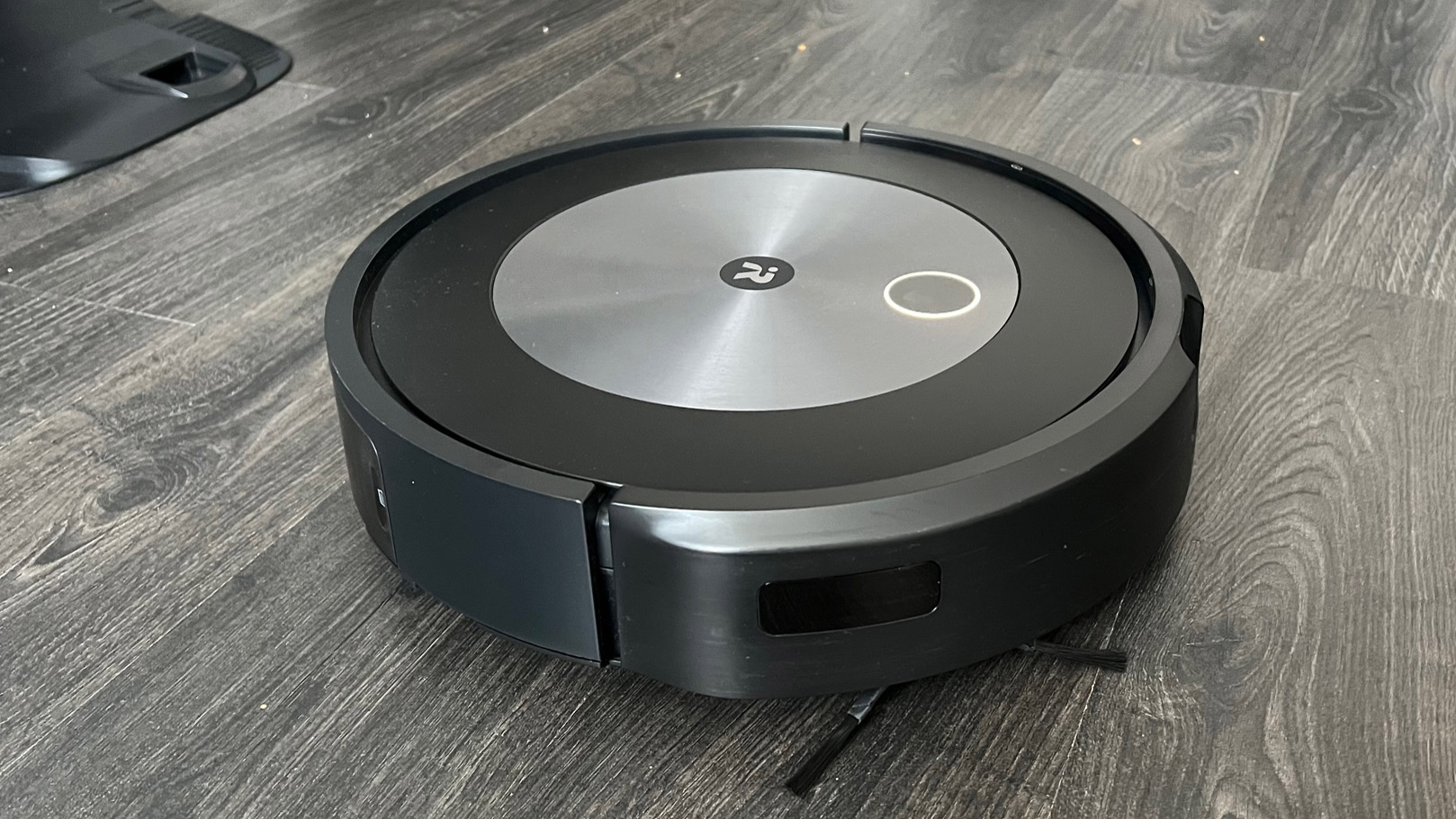
- Performance: 4/5
App
- Stores photos of obstacles
- Integration with Alexa and Google Assistant
- Access your favorite rooms easily
Connecting to the iRobot Home App was straightforward enough. We simply downloaded the app, created an account then connected to Wi-Fi and paired the vacuum with our smartphone. We also found it very easy to link to our Alexa voice assistant.
It would have been nice to have more cleaning controls on the actual iRobot so you can clean without using the app, but for a smart vacuum like this we found the app played a major role.
The iRobot app is simple to use. It's clearly laid out, with an easy way to name the j7+ and then ‘vacuum everywhere’. You can even name your vacuum, so we called it ‘Bruce’ – just because we’re Springsteen fans. It also gives you the option to easily create a schedule so you can set it to come on at a certain time or vacuum while you’re out. There’s also a messages box that gives you reminders about how to keep your robot ‘happy’, which we felt was a nice touch.
Sending the J7+ out on its maiden voyage via the app it will map your home as it cleans, including creating room boundaries and highlighting rooms with carpets. It’s then possible to edit the map, adjust the boundaries and assign names to the individual rooms. This will enable the J7+ to clean individual rooms, as well as the whole floor.
Once vacuuming is complete, the app provides an overview of the session, which covers the area cleaned, the time spent vacuuming, and the number of dirt events – or areas where the robovac noticed more dirt than usual. If the Roomba J7+ has encountered any obstacles, it will store pictures of these in the app, which can be reviewed and confirmed as a temporary obstacle, an area the robot vacuum should avoid, or a false positive. Even better, the Roomba can be sent back to clean up the areas it missed as a result of suspected obstacles in just one tap.
From the app, you can also create a schedule for times the robot vacuum should clean, and to adjust what the robot vacuum does when its dust canister is full. A feature that automatically brings up a feedback form when you take a screen grab proved extremely handy, making it easy to report any issues with the robot vacuum, and to get them resolved.
The J7+ is compatible with Alexa and Google Assistant, so you can use your voice, rather than the app, to start the robot vacuum cleaning your floors.
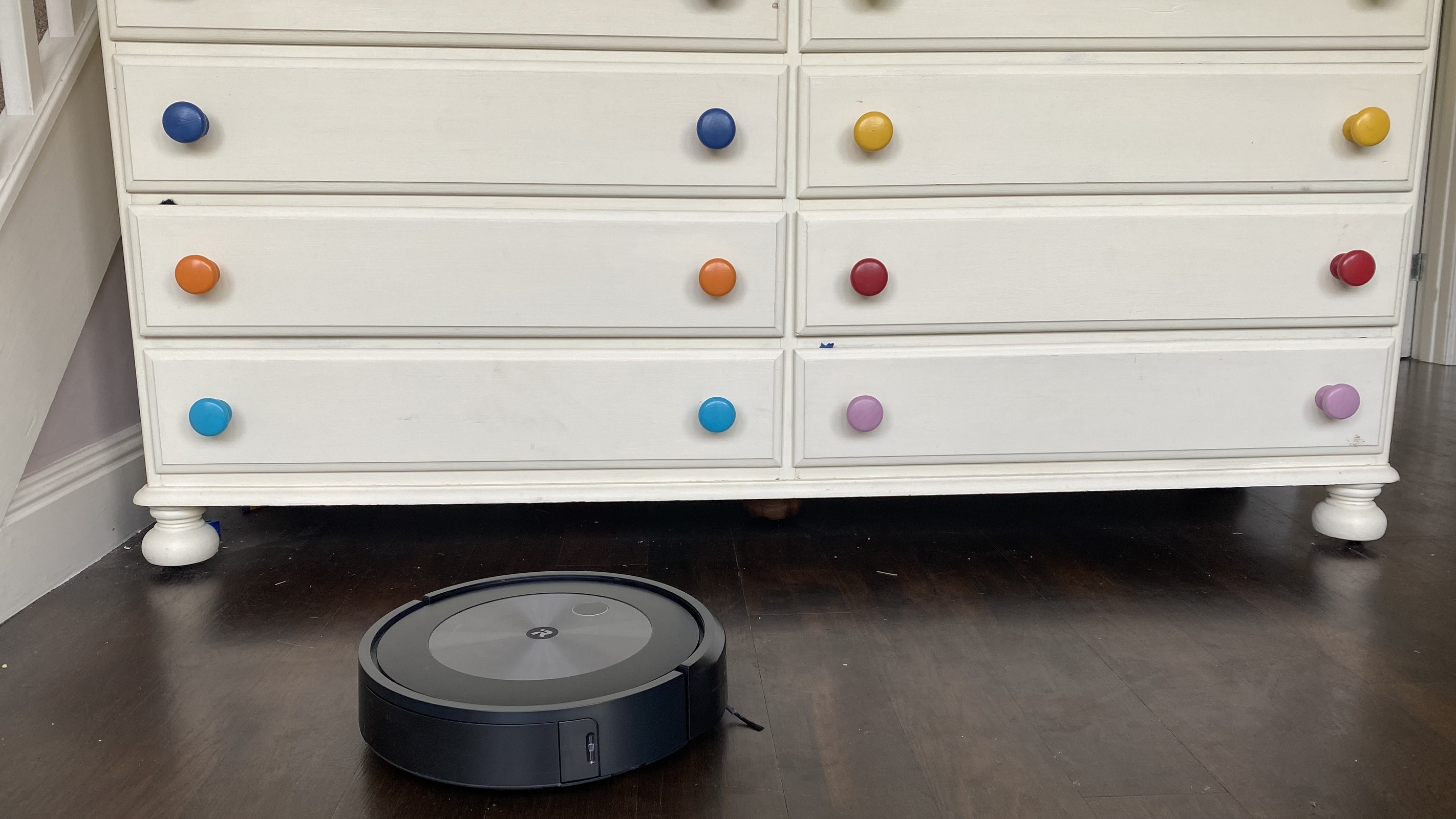
- App: 5/5
Battery life
- Will ‘intelligently recharge’ for the amount of time required to continue cleaning
- Battery takes around two hours to fully recharge from flat
- Indicator level doesn’t show a percentage
iRobot doesn’t make claims about how long the Roomba J7 Plus’s battery lasts between charges. However, the robot vacuum will automatically return to its charging station if it doesn’t have sufficient battery remaining to complete a clean. In these instances it will recharge just enough to finish the job.
We were able to clean both floors of a three-bedroom house on one full charge – but, annoyingly, the battery level doesn’t offer a percentage of time remaining, so we had to take a guess over how much charge was left. It took two hours to fully recharge the J7+.
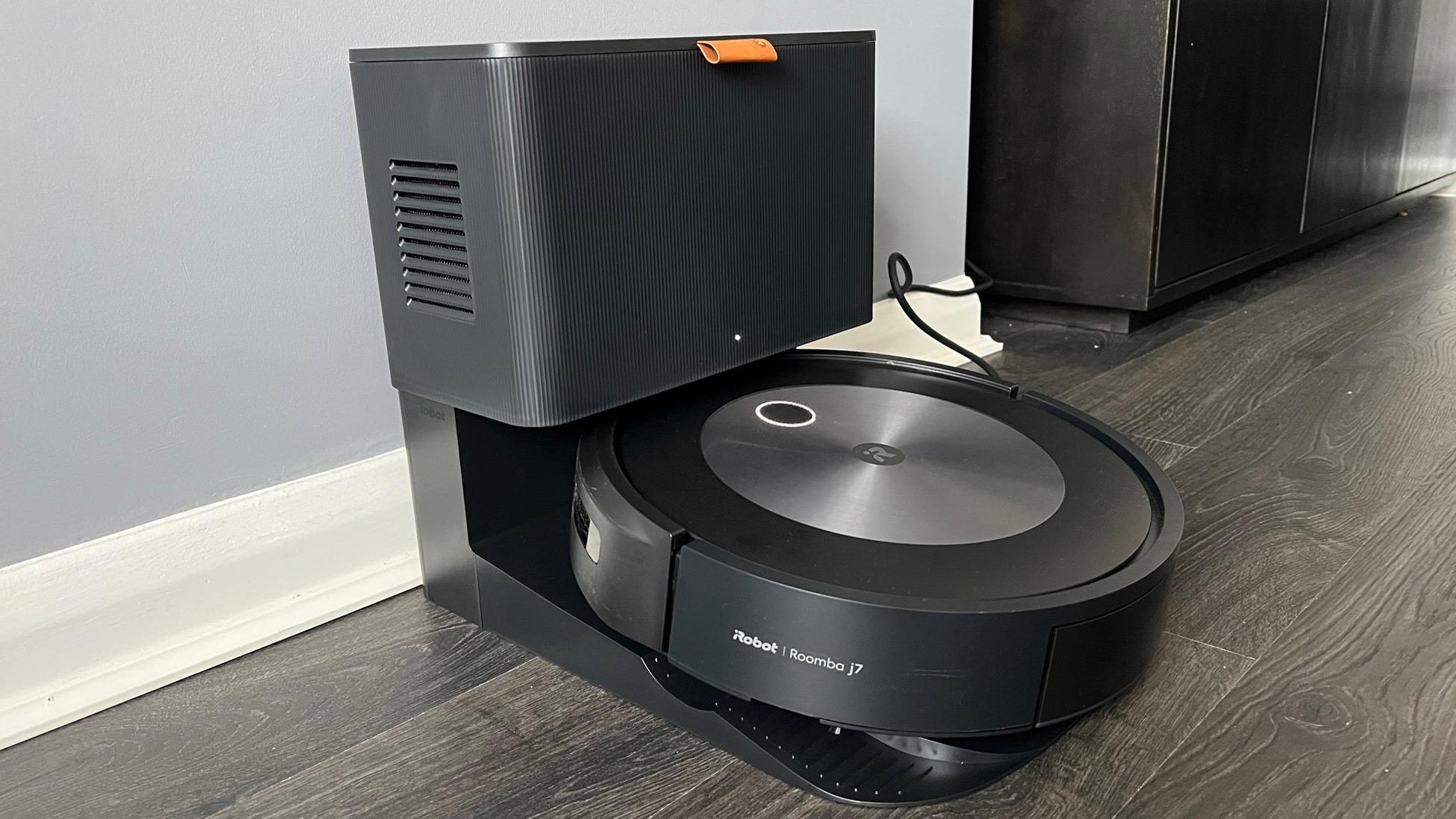
You’ll need to leave Roomba docked in its charging station to ensure it’s always ready to perform and connected to Wi-Fi. iRobot told us that it only uses a ‘very small amount of energy’ when docked, and it is possible to put it in a reduced power state via the app when it is not in use.
- Battery: 5/5
| Attributes | Notes | Rating |
| Design | Compact and with an excellent self-emptying feature and app controls, but could do with more controls on the actual body of the vacuum. | 4/5 |
| Performance | Picked up most day to day mess well, but struggled a little when presented with densely packed mess such as the sprinkling of oats and flour we set out. | 4/5 |
| App | Includes lots of useful features to stop and start the machine and tailor your vacuum to the exact area you would like cleaned using the smart map. | 5/5 |
| Battery life | Rather impressive run time and ability to find its way back to base when it needs to recharge. | 5/5 |
Buy it if...
You don’t want to clean up before vacuuming
For those who don’t want to have to pick up items such as stray charging cables, or the odd sock, off the floor before setting the robovac to clean, the J7+ is ideal. It will identify such items and avoid them.
You have pets
While some pets may be a bit scared of how loud the j7+ can get, it does a good job at avoiding humans and pets and cleaning pet dander and dust. And the best feature is that it will actively avoid pet mess.
You want a hands-off approach to vacuuming
This robot vacuum is self-emptying and can deposit the contents of its dust canister into the Clean Station itself. This means you only need to remove and replace the dirt disposal bag from the base station around once every 60 days, depending upon how often the robot vacuum cleans.
Don't buy it if...
You’re on a budget
While this isn’t the most expensive Roomba model on the market (that honor goes to the S9 Plus, which comes in at an eye-watering $1099.99 / £1499.99), it’s still one of the more expensive robovacs on the market. If you’re on a budget, consider the Roomba i3 or models from Eufy instead.
You don’t want on-going costs
The Roomba J7 Plus’s replacement dirt disposal bags cost $19.99 / £21.95 for three. If you don’t want to fork out for these, this is a robot vacuum to avoid.
You can’t bear noise
While the Roomba J7 Plus is pleasingly quiet while its working its way around carpets and hard floors, it’s excruciatingly noisy when emptying its dust canister – our decibel meter registered 90.6db, making it one of the loudest self-emptying models we’ve tested.
First reviewed: February 2022
Last reviewed: July 2022
- Check out there great robot vacuum deals
Carrie-Ann Skinner was formerly Homes Editor at TechRadar, and has more than two decades of experience in both online and print journalism, with 13 years of that spent covering all-things tech. Carrie specializes in smart home devices such as smart plugs and smart lights, as well as large and small appliances including vacuum cleaners, air fryers, stand mixers, and coffee machines. Carrie is now a copy editor at PWC.
- Emily PeckLifestyle journalist
